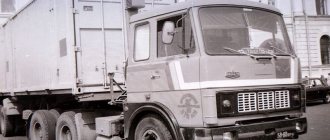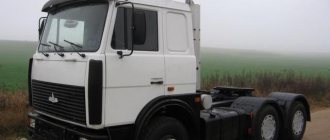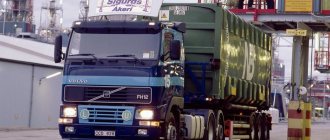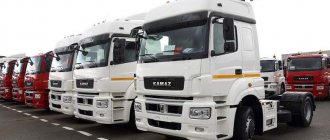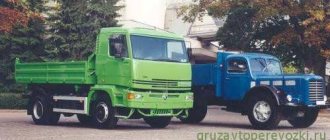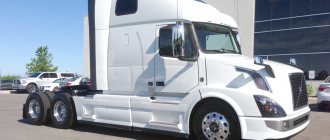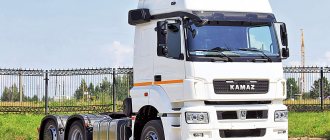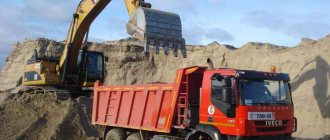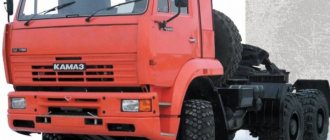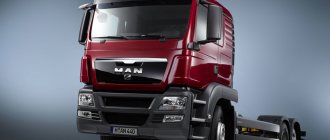A truck tractor called MAZ 504 became a “golden series 500” truck. It may sound too pretentious for an “old man” released back in 1965. However, it was this car that became a breakthrough in the design solutions of the Minsk Automobile Plant. During its history, the model has gone through many modifications and today non-serial production has long been completed.
Exterior
In order to improve the appearance of the truck, you need to do super MAZ tuning. You can start by replacing your outdoor lighting system. For example, change the headlights to alternative optics, which have a number of advantages compared to optics from the car factory:
- the level of color and light transmission increases;
- safety parameters are improved when traveling at night or in bad weather conditions;
- such optics have a longer service life;
- vibration resistance increases;
- maximum light output is achieved in less time;
- the exterior of the car is improved.
Such optics consume a small amount of electrical energy and do not overload the battery and generator set. The driver can install additional brake lights, reflectors, daytime running lights, a searchlight, and fog lights.
Another type of exterior tuning is the installation of an aerodynamic body kit, which will help reduce the level of air flow resistance, which will have a positive effect on the process of driving a vehicle. To improve these indicators, you can install wheel arch extensions, rear window visors, aerodynamic sills, and deflectors.
To preserve the protective paint coating of the sills, you can install mud flaps on the wheels. These elements are easy to install and have the following advantages:
- high level of impact resistance and wear resistance;
- do not require special care;
- tolerate sudden changes in temperature;
- resistant to aggressive environments.
The driver can install windshields that will prevent fogging of the windshield and side windows, create aerodynamic thrust while the vehicle is moving, protect the interior from snow, rain and wind, as well as the driver from drafts.
Daytime running lights will help reduce energy consumption, increase the level of protection, and will turn on automatically immediately after starting the engine.
Headlight protection is a transparent or carbon-style lining that protects headlights from chips, cracks, scratches and other mechanical damage. They are reliable, durable and easy to install.
"Golden Series"
MAZ-504 is part of the “golden 500th series”, which brought popularity to the manufacturer. Models in this series were assembled from completely new components and mechanisms that had not been used at the enterprise before. Thus, they differed in the design of the cabin, a more powerful engine, a shorter wheelbase, telescopic shock absorbers and a hydraulic steering wheel. For more than forty years, models in this series have been market leaders.
The MAZ-504 replaced the model with the working index 511. Its main difference from its predecessor was that it was designed for long trips with trailers and semi-trailers. The MAZ-511 dump truck did not have such an opportunity.
Several modifications were produced based on this model:
- MAZ-504B, which had a semi-trailer dump truck with hydraulic drive. Besides this, the modification had no other differences from the basic version.
- MAZ-504V. Developed for use in international transport. The model featured a more powerful engine.
Engine "MAZ-54323"
Truck tractors of this brand are equipped with the Yaroslavl diesel engine “YaMZ-238B”. This is an 8-cylinder liquid-cooled diesel engine, turbocharged and V-o6p (90°) cylinder arrangement. The technical parameters of this power unit are as follows:
- Working volume – 14.866 cubic centimeters;
- Power - 220 kW (300 hp), at 2000 rpm;
- Torque - 1177 Nm (120 kgf-m) at 1200-1400 rpm;
- Minimum idle speed – 600±50 min-1;
- Compression ratio – 15.2;
- The operating order of the cylinders is 1-5-4-2-6-3-7-8;
- Average piston speed – 9.33 m/s;
- Cylinder diameter – 130 mm, piston stroke – 140 mm;
- The weight of the engine without lubrication without gearbox is 1130 kg;
- Minimum specific fuel consumption – 208 g/kW h (153 g/hp h);
- Average effective pressure – 890.4 kPa (9.08 kgf/cm2);
- The engine service life before the first major overhaul is at least 10,000 hours.
Important How to install air conditioning on GAZelle Business class Next
The engine cylinder block is cast, made of low-alloy cast iron, cast as one piece with the upper part of the crankcase. The cylinder liners are of the “wet” type, made of alloy cast iron, with a water joint seal provided by three rubber rings. 2 cylinder heads - cast, made of low-alloy cast iron, one for each row of cylinders, with pressed seats and valve guides. The combustion chamber is single-cavity in the piston. Pistons are cast, made of high-silicon aluminum alloy.
The injection pump of this engine is 8-section, spool-type, with a low-pressure fuel priming pump, a fuel injection advance clutch and an all-mode speed controller. The air filter is dry, with a replaceable filter element and a clogging indicator. The YaMZ-238B engine is equipped with an electric torch device (EFD) to facilitate starting in cold weather. On the frame, this power unit is mounted on three supports: 1 front (bracket on the distribution gear cover) and 2 rear (located on both sides of the flywheel housing).
Technologically, the YaMZ-238B engine is similar to the YaMZ-238M2, and differs from it in the presence of a turbocharging system and associated design changes. The YaMZ-238B engine was originally developed specifically for MAZ road trains. It was also used as part of tractor equipment, front loaders and track machines, on dump trucks and bulldozers. Currently, this engine model is also no longer available.
Specifications
The MAZ 6422 truck has a load capacity of 14,700 kg and a standard ground clearance of 260 mm. Under the hood of the car, a YaMZ-6582(1) power unit is installed, depending on the model.
Indicators for the emission of harmful substances into the atmosphere comply with Euro-3 standards. The MAZ 6422 engine power is 330 hp. With.
The volume of the turbocharged diesel unit is 12,000 cubic centimeters.
The engine is combined with a ZF 16S-151 transmission with 16 gears of a mechanical operating principle.
Fuel consumption of MAZ 6422 is 33 liters. for 100 km of travel. These are performance indicators on the highway. In the combined cycle, 45.5 liters are required per 100 km.
Briefly about the history of the creation of the model and the successors of the MAZ-500
Prototypes of the MAZ-500, for comprehensive testing, were translated from drawings into reality in 1958, and in 1961 a pilot batch of 122 trucks of two basic types was assembled.
It must be said that not everyone unequivocally accepted the qualitatively new hoodless layout of the truck. To many, this idea seemed adventurous and even dangerous. Opponents of the new model had a strong and influential lobby. A meeting of the bureau of the Central Committee of the Communist Party of Belarus had already been scheduled with the agenda - to remove Vysotsky from the post of chief designer of the Minsk Automobile Plant, and to severely reprimand the general director of the enterprise Demin.
However, before this decision was made, the head of the Communist Party of Belarus, Filimonov, personally visited the plant, where all the advantages of the new model were clearly and convincingly demonstrated to him. The positive assessment of the chapter ultimately outweighed the arguments of the skeptics, and mass production of MAZs of the 500th series was given the green light. The rally of new cars held in 1961 along the route Minsk - Moscow - Leningrad - Riga - Minsk aroused great interest among specialists and the media.
Important KamAZ-65201: technical characteristics and review of modifications
But the specialists of the Minsk Automobile Plant, of course, did not receive the most necessary information about the advantages and disadvantages of the new model from cars participating in exhibitions and demonstration motor rallies, under the guns of reporters’ cameras.
The most valuable practical experience was gained in the process of analyzing the operation of trucks operating in the harsh conditions of Siberia and the Far North; at construction sites, in quarries, timber industry enterprises. Further, the MAZ-500 performed excellently not only in icy regions, but also in the sandy deserts of Africa and Asia, and on the high plateaus of Latin America.
In March 1965, the MAZ-500 was put into mass production at first in parallel with the MAZ-200. It is symbolic that the last copy of the outgoing model, the MAZ-200, rolled off the assembly line on December 31, 1965, and from 1966 the enterprise completely switched to producing cars of the 500th family.
For the successful introduction into production of this, by all indications, very promising model, in 1966 the Minsk Automobile Plant was awarded the highest state award - the Order of Lenin. The enterprise reached its design capacity (24 thousand trucks per year) within two years.
The car was distinguished by a characteristic decorative lining of the radiator grille of 14 vertical ribs, and a casing attached to the rear wall of the cab. The cabin itself, for its smooth and streamlined shape, was nicknamed “globe” among drivers, and the 500th MAZ was nicknamed “lobaty.”
Based on the basic model, a whole range of trucks, universal chassis and road trains with increased payload capacity were developed and put into production. More details about all the series-produced and small-scale modifications of the 500 family can be found in the next section.
In 1970, the MAZ-500 car was replaced on the factory assembly line by its successor, the MAZ-500A, with a wheelbase increased by 100 mm (to 3950 mm) and a payload capacity increased to 8 tons. Overall dimensions have been brought into compliance with European standards. The final drive gear ratio was changed, as a result of which the maximum speed of the vehicle increased from 75 to 85 km/h (at full load, on a horizontal section of the highway).
Important Premium segment tractor KamAZ-54901 with K5 cab
The “three pillars” of the Minsk Automobile Plant - a flatbed truck, a dump truck and a truck tractor - received a new prefix to their indices, and began to be called MAZ-500A, MAZ-503A and MAZ-504A, respectively. Externally, the second generation 500s could be distinguished by a different, “checkered” radiator grille. In addition, the casing behind the cab has disappeared. Behind the doors, at the level of the door handle, a turn signal repeater appeared.
In this updated version, the 500th remained on the assembly line of the Minsk Automobile Plant until 1977, when the time came to launch a completely new family of trucks - the MAZ-5335.
Modifications
In 1970, experimental work was completed, and mass production of the improved version 504A began. From the point of view of external design, the new product could be distinguished by a different shape of the radiator grille. Most of the changes were made to the interior space and improvements to the technical part:
- Firstly, it has a 240-horsepower turbocharged engine that can increase towing capacity to 20 tons. The wheelbase has become smaller by 20 centimeters. The springs have also been lengthened. And the truck’s ride has become smooth and predictable;
- Secondly, the cabin has a dining table and sun visors. There are also curtains that cover the windows. The upholstery was replaced with a softer one (at least a little sound insulation appeared).
Model history
The first serial truck tractor of the MAZ-5432 series was assembled on the main assembly line of the Minsk Automobile Plant on May 19, 1981. This day is considered to be the starting point in the history of Belarusian third-generation long-haul trucks. The carrying capacity of this tractor reached 21 tons, and the total weight was 34 tons. In addition, this family was distinguished by a qualitatively new type of cabin with a double berth of large volume, more modern equipment and the presence of a transverse stabilizer in the front suspension design.
Launched into serial production in 1985, the MAZ-54322, with the YaMZ-238F2 diesel engine, and in 1988, the MAZ-54323, with the YaMZ-238B engine, were distinguished by an even more comfortable cabin and a modified design of the front part. Specialists took part in the development of the MAZ-54323 model. In particular, the cabin was equipped using technological solutions from MAN cabins of the F-2000 series. And in the same 1988, MAN’s 360-horsepower diesel engines were first supplied to MAZ (in the MAZ-54326 modification).
In 2000, these trucks, which by that time were among the leaders in production volume, had drive axles equipped with cross-axle differential locks, and the new front axle began to withstand a load of up to seven tons, and provide a steering angle of up to 45 degrees. .
Production of the MAZ-54323 and other 5432 series trucks was finally completed by 2008, when they were replaced by newer and more modern MAZ-5440. Do not confuse two- and three-axle Minsk mainline tractors: they have three axles.
Prices and car analogues
The cost of MAZ-504 V tractors that have undergone major repairs is 250-300 thousand rubles. The equipment is not found in original condition. It is impossible to find early production vehicles or tractors designed to work with dump semi-trailers. Such equipment worked for several years and was disposed of; instead, new equipment was supplied from the factory. Analogues are the MAZ-5432 tractor, equipped with a 280-horsepower diesel engine with a turbocharger, or the MAZ-5429 truck, equipped with a 180-horsepower YaMZ 236 naturally aspirated engine.
Device
The design of the MAZ 504 car was almost identical to the entire 500 series.
The diesel engine, which was discussed earlier, had a water cooling system (closed type), a mixed lubrication subsystem, separate fuel equipment and a control fuel consumption of 32 liters per 100 km.
The transmission was installed completely mechanical, with a 5-speed gearbox and a friction dry clutch (of 2 discs). The main gear consists of two cone-shaped gears and one spiral tooth.
The MAZ 504 tractor was equipped with a foot brake (pneumatic, shoe type, all-wheel drive) and a parking brake (centrally located, also shoe type).
The chassis consisted of a riveted frame, a towing device (fork type), spring suspension, telescopic shock absorbers with hydraulic drive, a forged front beam and discless wheels.
The front single-pitch and rear dual-pitch tires had dimensions 11.00 - 20*14.
The cabin, in addition to its innovative cabover structure, was made entirely of metal, had a welded structure and 2 side doors. To facilitate MAZ maintenance, the cab tilted forward 45 degrees relative to the front pillars.
In the transport position, the cabin was secured with a reliable locking mechanism.
Initially, many engineers were concerned about the question: would the lock that keeps the cabin from tipping over open on bumps? It came to the point of harsh criticism and outright censure of the chief engineer of the plant, M.S. Vysotsky.
However, tests have proven the ability of the locking mechanisms to ensure 100% locking of the cabin even in emergency situations. But the absence of a hood significantly reduced the overall weight of the car and reduced the load on the front axle, which made it possible to increase the overall carrying capacity of the vehicles.
Inside the cabin there was an adjustable driver's seat, a double passenger seat, a sleeping shelf, drawers for things and tools, a heater and a fan. The cabin was illuminated by an overhead lamp and instrument lighting bulbs.
The platform was also welded, the so-called universal type with a mechanically opening and closing rear side. 2-joint fifth wheel coupling with lockable auto-lock.
The first modification of the basic tractor was released in the same 1965 and received the index 504B. It was a vehicle designed to operate with a tipper-type semi-trailer. The technical characteristics of the MAZ 504 B were no different from the main version, with the exception of the platform lifting device.
The lifting of the loading platform was carried out using a built-in hydraulic system consisting of one telescopic cylinder, directly acting on the surface being lifted, and a gear hydraulic pump attached to the edge of the power take-off.
While in the cab, the driver activated the pneumatic drive, which in turn acted on the OM box and the main valve, the MAZ platform was raised (maximum 55 degrees), if necessary, it was possible to additionally shake the platform using a special valve.
After unloading through the tailgate, the driver again activated the pneumatic system, and the platform returned to its original position.
In general, the resulting tractor was not bad, it took a worthy place in its niche - transporting goods over short and medium distances, but the ideal was still far away. The working conditions on the MAZ 504 could not be compared with foreign-made saddlebags.
180 horsepower was clearly not enough to work over long distances. And the cargo towing capacity of 13.5 tons was too small for the 504s to create competition in long-haul transportation.
It was necessary to increase the load capacity, increase comfort, and reduce cabin vibrations and vibrations.
Fortunately, the overall success of the 500 series cars encouraged the plant's designers to undertake another modernization according to the motto: “bigger, more reliable, more durable.” Beginning in 1968, the plant began preparing to update the 500 series, purchasing new cutting machines and metal equipment for stamping improved MAZ parts began, and advanced production technologies were purchased and mastered.
Cabin exterior
The cabin of the current MAZ 6422 truck tractor differs from earlier versions. Changes affected the exterior of the car, grille and front lighting. The cabin looks monolithic. Gone are the smooth and protruding forms that were popular in the middle of the last century. The windshield of the tractor has been modernized. The classic, split glass version has been replaced by a safe panoramic view.
The previously ridiculous looking bumper was replaced with a design with modernized headlights. On the roof of the truck tractor there is now a spoller of an improved design.
